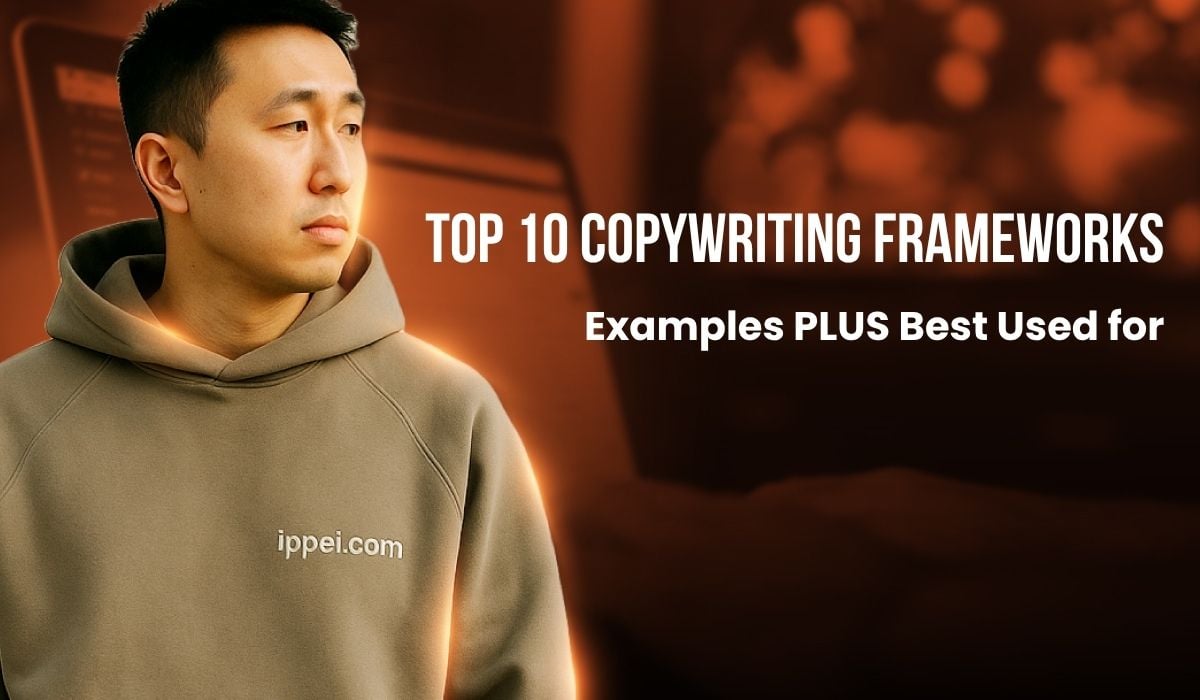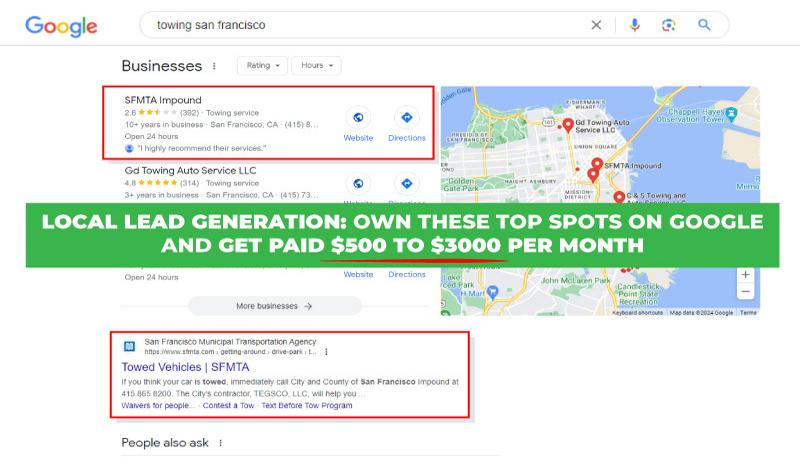Top 10 Copywriting Frameworks — Examples PLUS Best Used for

The top copywriting frameworks are:
- AIDA (Attention, Interest, Desire, Action)
- PAS (Problem–Agitate–Solution)
- BAB (Before–After–Bridge)
- The 4 Ps (Picture, Promise, Proof, Push)
- FAB (Features–Advantages–Benefits)
- PASTOR (Problem, Amplify, Story, Transformation, Offer, Response)
- ACCA (Awareness, Comprehension, Conviction, Action)
- QUEST (Qualify, Understand, Educate, Stimulate, Transition)
- The 4 C’s (Clear, Concise, Compelling, Credible)
- The 4 U’s (Useful, Urgent, Unique, Ultra-Specific)
Copywriting frameworks provide structured formulas that help marketers create persuasive and high-converting content. These frameworks simplify the writing process by guiding the audience through a logical flow. It is easier to capture attention, build interest, and drive action. The right copywriting framework makes your ads, sales pages, emails, and landing pages clear and effective.
AIDA guides readers through a clear persuasion process. PAS focuses on addressing pain points before presenting a solution. Other popular structures, like BAB and FAB, let you tailor messages for different audiences and industries. This includes e-commerce, SaaS, coaching, and direct-response marketing.
Using a proven framework can increase conversion rates, reduce writing time, and make copy more persuasive. Using the right copywriting framework is key for ads, product descriptions, or sales pitches. It helps you hit your marketing goals.
Dan Koe teaches that persuasion is the most powerful skill for success in the modern world. To communicate effectively, he recommends using structured copywriting frameworks instead of writing randomly. For persuasive writing, he highlights AIDA . BAB demonstrates transformation, while PASTOR fosters trust and enables effective selling. He also stresses the importance of understanding your audience’s awareness level. He adds that CORTEX helps organize ideas and refine writing.

Copywriting frameworks can be a game-changer when it comes to making money online. They create convincing content that works in ads, landing pages, and sales emails. While copywriting is a valuable skill, I’ve discovered a more profitable and scalable business model. This approach helps you create digital assets. These assets earn steady income automatically. You won’t need to chase clients, write endless revisions, or wait for payments.
In this article, I discuss how AIDA, PAS, and QUEST work and what they mean. I also provide specific examples to help you apply them to your blog. Finally, I share the top use cases for each copywriting framework, from landing pages and storytelling to email campaigns, product launches, and sales copy.
1. AIDA (Attention, Interest, Desire, Action)
AIDA is a classic four-step framework that leads the reader from first noticing your message to taking action. You grab Attention with a strong hook or headline. Interest shows something interesting or relevant. Desire highlights benefits or solves a problem. Finally, it prompts a clear Action (such as a call-to-action to buy or sign up).
Example:
- Attention: “Tired of waking up exhausted, even after 8 hours of sleep?” – (Draws the reader in by addressing a relatable frustration).
- Interest. “Meet the DeepRest Pillow. Sleep scientists created it to increase REM sleep by 40%. This offers an exciting new solution.”
- Desire. “Join 10,000 happy customers who wake up refreshed and full of energy each morning.”
- Action: “Order today and get a free sleep tracker—limited-time offer!”
AIDA is a versatile tool, similar to a Swiss Army knife for copy. It’s best used for ads and headlines to grab attention. Landing and sales pages to keep interest and drive action. Email marketing campaigns(where early attention is key.
2. PAS (Problem–Agitate–Solution)
PAS is a three-part framework focusing on the audience’s pain points. First, you state a Problem that the reader is facing (show you understand their need). Next, you Agitate the problem. You amplify the pain by describing consequences or emotions to make it feel urgent. Now, share your Solution. Show how your product or idea solves the problem and eases the pain.
Example:
- Problem. “Your business has a great product, but your website barely gets any traffic.” – (Directly addresses a common struggle for business owners).
- Agitate. “Without traffic, your site is just a digital ghost town. Your potential customers can’t find you. Meanwhile, your competitors make all the sales. Don’t just wait and hope for visitors who never arrive.”
- Solution. “TrafficFlow Pro uses AI for SEO and ad strategy. It quickly gets your website in front of the right audience.” More visitors, more leads, and more sales without the guesswork!”
PAS shines in copy where empathy and storytelling is crucial. It’s great for landing pages, blog post intros, and video scripts. You can explain a problem and its importance before presenting your solution. Marketers often use PAS in social media ads or emails. They start with a pain point to grab attention, then offer a quick solution.
3. BAB (Before–After–Bridge)
The BAB framework shows a before-and-after scene. It positions your offer as the bridge that connects them. You start by describing the Before. This is the current world where the reader has a challenge or is missing out. Then you illustrate the After. It’s about how much better life could be once the problem is solved or the need is fulfilled. Finally, you introduce your product or service as the Bridge. It links the current state to the desired future state, enabling that change.
Example:
- Before: “Struggling to get new clients? You send out proposals, but weeks pass with no responses.”
- After. Imagine your inbox filling up with replies, your calendar packed with clients, and your revenue growing."
- Bridge. “PitchPerfect Pro is our AI tool that helps you create offers that stand out. It turns silence into sales!”"
BAB works brilliantly in storytelling-driven campaigns showing a transformation. Use it in case studies, testimonials, or landing pages for products that clearly improve something (health, productivity, finances, etc.). It’s also great for video ads and commercials. You can show a “before” and “after” to pull at emotions.
4. The 4 Ps (Picture, Promise, Proof, Push)
The 4 Ps formula builds persuasion through four elements. Picture paints a vivid image of the reader’s problem or an aspiration they have. Promise is a strong commitment. Show how your product or service will solve that problem or meet the need. Proof provides evidence to back up your promise. You can add statistics, testimonials, case studies, or guarantees. Push “pushes” the reader to take action with a clear and urgent call to action.
Example:
- Picture. “You spend hours crafting the perfect email, only for it to sit unread in inboxes—lost in a sea of unopened messages.”
- Promise. “Imagine your emails standing out right away. They could have subject lines that grab attention and copy that drives conversions.”
- Proof. “Our AI writing assistant has helped over 10,000 marketers. It boosts email open rates by 67%. This is thanks to real-time optimization based on data.”
- Push. “Try it for free today! You’ll notice better results in your next campaign—your inbox deserves it!”
The 4 Ps framework is excellent when you have strong proof or testimonials to build trust. It’s often used in sales letters, product landing pages, and cold emails. You need to quickly grab the reader’s attention with a scenario. Then, you provide evidence to reassure them before they ask questions.
5. FAB (Features–Advantages–Benefits)
FAB is a straightforward framework that translates product features into customer benefits. First, state the Feature or what your product or service has or does. Then, explain the Advantage or why that feature matters or what it does better than others. Lastly, highlight the Benefit or how it helps the customer or solves a problem for them.
Example:
- Feature: “Adjustable height with memory presets for sitting and standing positions.”
- Advantage. “Switch from sitting to standing with one button. This lessens back strain and boosts your posture.”
- *Benefit. “Stay energized all day, avoid back pain, and boost productivity—without disrupting your work.”*
FAB works great for product descriptions, e-commerce pages, and sales brochures. It helps you present product details clearly and engagingly. Use FAB in emails or landing pages when launching a new feature or writing an Amazon listing.
6. PASTOR (Problem, Amplify, Story, Transformation, Offer, Response)
The PASTOR framework is a six-step method created by copywriter Ray Edwards. It writes empathetic and engaging sales copy. Problem starts by identifying the reader’s pain or need. Amplify emphasizes the consequences of not solving that problem. Story shares a relatable story or example that highlights the problem and sets up a solution. Transformation describes the change or outcome once the problem is solved. Show the reward or results that often include introducing your solution. Offer your product or service as the way to change lives. Include details about what’s inside and any special bonuses. Response ends with a clear call to action, asking the reader for a response.
Example:
- Problem. “You’ve been trying to learn Spanish for months, but you still struggle to hold a real conversation.”
- Amplify. “Whenever you go to a Spanish-speaking country, you feel stuck using Google Translate.” It’s embarrassing, and it holds you back from truly experiencing the culture."
- Story. “I know exactly how you feel. A year ago, I was in a restaurant in Barcelona, trying to order dinner. I fumbled over my words, the waiter looked confused, and I ended up pointing at the menu in defeat. That’s when I knew I needed a new way to learn—not just memorizing words but actually speaking confidently.”
- Transformation. “Today, I chat easily with locals, travel stress-free, and make friends worldwide.” Imagine finally speaking Spanish fluently and feeling confident in every conversation!"
- Offer. I launched Fluent in 60. It’s a conversation-first language program. You can achieve fluency in Spanish in 8 weeks. No boring textbooks—just real-world practice that gets results. You’ll enjoy interactive lessons, live speaking practice, and personal coaching. This will help you boost your fluency fast."
- Response: “Don’t let another year go by without speaking the language you’ve always wanted to learn. Join Fluent in 60 today and start having real conversations in just weeks!”
PASTOR works well for long sales copy. This includes sales letters, webinar pitches, and detailed landing pages. You can build an emotional connection and address your audience in depth. It’s particularly useful in email marketing sequences and sales funnel pages for high-value products or services (coaching, courses, etc.).
7. ACCA (Awareness, Comprehension, Conviction, Action)
ACCA consists of four steps. It takes a more informative and educational approach. Awareness catches the reader’s eye. It shows an issue or chance they may not see. Comprehension gives information or explanations. Reader will understand the problem or solution and its impact on them. Conviction strengthens the reader’s belief and desire. Tap into their emotions or logic, urging them to take action. Show benefits, success stories, or remove doubts. Finally, Action prompts the reader to take the next step (sale, sign up, etc.) once they’re convinced.
Example:
- Awareness. “Every day, cybercriminals steal sensitive data from businesses. Most attacks succeed when employees unknowingly open the door.”
- Comprehension. “Phishing emails, weak passwords, and social engineering tricks can make careful employees vulnerable.” Our CyberSafe Training shows your team how to spot and stop cyber threats before they occur."
- Conviction. “Companies that implement cybersecurity training see a 70% drop in security breaches. CyberSafe uses interactive lessons and real-world simulations. It has helped thousands of businesses stay safe and avoid costly cyberattacks.”
- Action. “Don’t wait until it’s too late. Enroll your team today and get a free security audit! Stay ahead of cybercriminals—protect your business now.”
ACCA works well for products or services that require explaining to customers or changing their mindset. It’s perfect for educational content, whitepapers, and detailed landing pages or sales letters. You need to inform the reader. Marketers use ACCA in email sequences and product launches to nurture leads.
8. QUEST (Qualify, Understand, Educate, Stimulate, Transition)
The QUEST framework is a storytelling-oriented formula that guides the reader through a journey from identifying who they are to taking action. Qualify means you start by qualifying your audience. Call out who this message is for, so the right people pay attention. Understand shows that you understand their needs or pain points. Educate provides information, solutions, or insight addressing the problem. This is where you introduce your product or key message as helpful knowledge. Stimulate excites the reader by highlighting what makes your solution compelling or unique. Finally, Transition smoothly transitions to the call to action. Encourage the reader to take the next step now that they’ve followed your narrative.
Example:
- Qualify. “Freelancers, do you ever feel like there aren’t enough hours in the day?”
- Understand. “Juggling many projects and chasing invoices can be tiring. It’s hard to find time for yourself.” You shouldn’t have to work late nights just to stay ahead."
- Educate. “The problem isn’t the amount of work—it’s how it’s managed. TaskFlow is a smart app for freelancers. It helps them prioritize tasks, automate reminders, and easily track billable hours.”
- Stimulate. “Imagine waking up knowing exactly what needs to be done—no more scrambling or missed deadlines. With TaskFlow, our users save an average of 10 hours per week and get paid faster, stress-free.”
- Transition. “Take charge of your schedule now. Try TaskFlow free for 14 days. Enjoy a smoother, organized workflow!”
QUEST works well for product launches, email campaigns aimed at specific groups, landing pages for certain audiences, and ads targeting niche markets. Because it starts by qualifying the reader, it works best if you know exactly who you’re speaking to. Use QUEST for warm leads or niche markets.
9. The 4 C’s (Clear, Concise, Compelling, Credible)
The 4 C’s framework ensures that your copy is effective by focusing on four essential qualities. Clear makes your message easy to understand. Concise gets to the point without unnecessary fluff. Compelling engages the reader with strong messaging. Credible builds trust with facts, statistics, and social proof.
Example:
- Clear: “Not getting interview calls?”
- Concise: “Create a job-winning resume in just 5 minutes.”
- Compelling: “Land your dream job faster with an ATS-optimized resume.”
- Credible: “Trusted by over 250,000 professionals with a 92% success rate.” The 4 C’s are great for website copy, ad headlines, and product descriptions. They help make messaging strong and direct. It makes marketing materials clear. This includes emails, landing pages, and social media posts. Readers can easily understand and take action.
10. The 4 U’s (Useful, Urgent, Unique, Ultra-Specific)
How it works: The 4 U’s formula is a technique used to create attention-grabbing and action-driven copy. Useful provides immediate value to the reader. Urgent encourages immediate action with time sensitivity. Unique stands out with a fresh, original approach. Ultra-Specific delivers clear, targeted information.
Example:
- Useful: “Learn to code and land a remote job in just 3 months.”
- Urgent: “Enrollment closes in 48 hours—secure your spot now!”
- Unique: “A hands-on curriculum designed by Silicon Valley engineers.”
- Ultra-Specific: “Over 10,000 students placed in tech jobs with salaries starting at 0K+.”
The 4 U’s are best for email subject lines, ad copy, and landing pages where immediate impact is required. They work well for short, strong messages. You can use the 4U’s for headlines, social media captions, and call-to-action buttons. This helps engage the audience and prompts a response.
Why is Local Lead Generation Better Than a Copywriting Business?
Local lead generation is better than copywriting because it offers higher income, more passive earnings, and long-term growth. A local lead gen website can make $500-$5,000 per month per client. If you build multiple sites, you can earn $10,000-$50,000 per month with little ongoing work. Copywriting needs ongoing effort. You have to write regularly, find clients, and finish projects to keep making money.
With local lead generation, you can start making money in 3-9 months after your site ranks on Google. Once ranked, it can bring in income for 3-10+ years with very little maintenance. In contrast, copywriters only get paid when they write, meaning no work = no income. Even top copywriters making $50,000-$100,000 per year have to keep working nonstop to maintain that income.

Local lead generation is more passive. After setting up your site, businesses pay you monthly for leads. Lead gen websites are like digital real estate. They keep earning money for you, even when you’re not working. This is different from copywriting, where you need to create new content all the time.

Follow Me
Ippei Kanehara
Founder/CEO
$52K per month providing lead generation services to small businesses
Ippei.com is for digital hustlers, industry leaders and online business owners.
His #1 online business recommendation in 2024, is to build your own lead generation business.